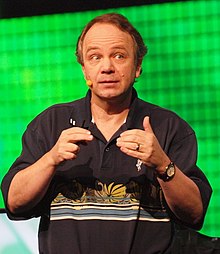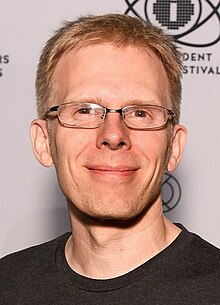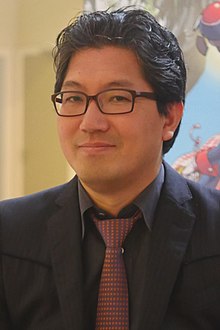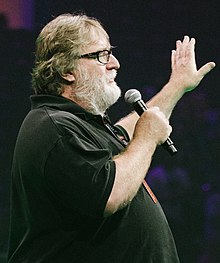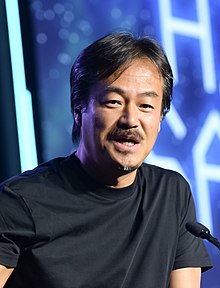Portal:Video games
Portal maintenance status: (January 2025)
|
The Video Games Portal

A video game, sometimes further qualified as a computer game, is an electronic game that involves interaction with a user interface or input device (such as a joystick, controller, keyboard, or motion sensing device) to generate visual feedback from a display device, most commonly shown in a video format on a television set, computer monitor, flat-panel display or touchscreen on handheld devices, or a virtual reality headset. Most modern video games are audiovisual, with audio complement delivered through speakers or headphones, and sometimes also with other types of sensory feedback (e.g., haptic technology that provides tactile sensations). Some video games also allow microphone and webcam inputs for in-game chatting and livestreaming.
Video games are typically categorized according to their hardware platform, which traditionally includes arcade video games, console games, and computer games (which includes LAN games, online games, and browser games). More recently, the video game industry has expanded onto mobile gaming through mobile devices (such as smartphones and tablet computers), virtual and augmented reality systems, and remote cloud gaming. Video games are also classified into a wide range of genres based on their style of gameplay and target audience. (Full article...)
Featured articles – load new batch
-
Image 1

Pirates of the Caribbean: Armada of the Damned is a cancelled action-adventure role-playing video game that was being developed by Propaganda Games for the PlayStation 3, Xbox 360, and Microsoft Windows platforms. Originally set to be published by Disney Interactive Studios, it was the first attempt to create an open world game based on the Pirates of the Caribbean film franchise. The project was cancelled in October 2010, soon before the closure of Propaganda Games.
Set roughly ten or fifteen years before events of The Curse of the Black Pearl, the game was to follow James Sterling, a pirate captain whose main mission was to travel across the Caribbean Sea to make a reputation for himself. Although little was unveiled about the story, it was intended to be independent from the films' main arc and include new characters. Gameplay was to have emphasized role-playing elements, including real-time combat and weapon customization.
After its announcement at 2009's Electronic Entertainment Expo, the game received positive responses from most video game journalists. Daemon Hatfield from IGN thought it "a promising action RPG", while GamesRadar praised the gameplay, comparing it to the Assassin's Creed franchise. Journalists were disappointed when Disney cancelled the game several months before its planned release date. Ubisoft, the publisher of Assassin's Creed, later released Assassin's Creed IV: Black Flag with similar role-playing gameplay elements. (Full article...) -
Image 2Teardown is a 2022 sandbox–puzzle video game developed and published by Tuxedo Labs. The game revolves around the owner of a financially stricken demolition company, who is caught undertaking a questionable job and becomes entangled between helping police investigations and taking on further dubious assignments. Teardown features levels made of destructible voxels, and the player follows the campaign through consecutive missions. In most missions, the player must collect or destroy objects connected to a security alarm that triggers a timer. The player has unlimited time to prepare and is given upgradable tools, vehicles, and explosives to create a path within the level that allows them to complete the objectives and reach a getaway vehicle before the timer runs out.
Teardown uses a proprietary game engine developed by Dennis Gustafsson, who began developing the technology after winding down his previous company, Mediocre, in 2017. He initially implemented destructible voxels with ray tracing and, after several discarded designs, conceived the two-phase heist concept. While working closely with the former Mediocre designer Emil Bengtsson, Gustafsson regularly shared development updates via Twitter and the resulting popularity led him to not pursue traditional marketing for Teardown. The game was announced in October 2019 and an early version was available through early access from October 2020, with the full game released in April 2022.
Teardown saw positive reactions leading up to and during its early access phase, and it received favourable reviews upon release. Critics praised the game's physics, interactivity, graphics implementation, art style, and music. Mixed opinions were voiced regarding the campaign progression and story, while some control elements were criticised. The game's support for mods was cited as a major factor for its potential longevity. Teardown had sold 1.1 million copies by August 2022, and the game's success led to Tuxedo Labs being acquired by Saber Interactive under Embracer Group. PlayStation 5 and Xbox Series X/S ports, published by Saber Interactive, were released in November 2023, upping the player count to 2.5 million. (Full article...) -
Image 3Rare Replay is a 2015 compilation of 30 video games from the 30-year history of developers Rare and its predecessor, Ultimate Play the Game. The emulated games span multiple genres and consoles—from the ZX Spectrum in 1983 to the Xbox 360 in 2008—and retain the features and errors of their original releases with minimal edits. The compilation adds cheats to make the older games easier and a Snapshots mode of specific challenges culled from parts of the games. Player progress is rewarded with behind-the-scenes footage and interviews about Rare's major and unreleased games.
The compilation was one of several ideas Rare considered to celebrate its 30th anniversary. Inspired by fans, upcoming Xbox One backward compatibility features, and a desire to link Rare's past and future, the company sorted through 120 games to choose those that best represented its oeuvre. It prioritized games with characters and environments original to the company. Rare incorporated four hardware emulators in the package, and worked with its parent company, Microsoft, to use its then-unannounced Xbox 360 emulation. Rare Replay released worldwide as an Xbox One exclusive on August 4, 2015.
Rare Replay's reviews were generally favorable. Critics appreciated the package's design and craft and called the release a new pinnacle for compilation releases. They commended its "rewind" and Snapshot features, but criticized technical issues in the Xbox 360 emulation and game installation. Among its games, reviewers preferred Rare's Nintendo 64 games, especially Blast Corps, and disliked Perfect Dark Zero, Grabbed by the Ghoulies, and the Spectrum games. Some outlets lamented the absence, due to licensing issues, of the Donkey Kong Country series and GoldenEye 007, while others thought the package was fine without them. Critics deemed the archival game content and developer interviews as among the compilation's best features, but were upset to see the content hidden behind time-consuming in-game challenges. Rare Replay became Rare's first United Kingdom all-formats charts bestseller since Banjo-Kazooie in 1998. (Full article...) -
Image 4God of War II is an action-adventure hack and slash video game developed by Santa Monica Studio and published by Sony Computer Entertainment (SCE). First released for the PlayStation 2 on March 13, 2007, the game is the second installment in the God of War series, the sixth chronologically, and the sequel to 2005's God of War. It is based on Greek mythology and set in ancient Greece, with vengeance as its central motif. The player character is protagonist Kratos, the new God of War who killed the former, Ares. Kratos is betrayed by Zeus, the King of the Olympian gods, who strips him of his godhood and kills him. Slowly dragged to the Underworld, he is saved by the Titan Gaia, who instructs him to find the Sisters of Fate, as they can allow him to travel back in time, avert his betrayal, and take revenge on Zeus.
The gameplay is similar to the previous installment. It focuses on combo-based combat which is achieved through the player's main weapon—the Blades of Athena—and secondary weapons acquired throughout the game. It features quick time events (QTEs) that require players to quickly complete various game controller actions to defeat stronger enemies and bosses. The player can use up to four magical attacks and a power-enhancing ability as alternative combat options. The game also features puzzles and platforming elements. Compared to its predecessor, God of War II features improved puzzles and four times as many bosses.
God of War II received critical acclaim, and is considered as one of the best video games of all time and was 2007's "PlayStation Game of the Year" at the Golden Joystick Awards. In 2009, IGN listed it as the second-best PlayStation 2 game of all time, and both IGN and GameSpot consider it the "swan song" of the PlayStation 2 era. In 2012, Complex magazine named God of War II the best PlayStation 2 game of all time. The game had sold 4.24 million units by June 2012, making it the sixteenth-best-selling PlayStation 2 game of all time. God of War II, along with God of War, was remastered and released on November 17, 2009, as part of the God of War Collection for the PlayStation 3 (PS3). The remastered version was re-released on August 28, 2012, as part of the God of War Saga, also for the PlayStation 3. A novelization of the game was published in February 2013. A sequel, God of War III, was released on March 16, 2010. (Full article...) -
Image 5Nights into Dreams is a 1996 action game developed by Sonic Team and published by Sega for the Sega Saturn. The story follows the teenagers Elliot Edwards and Claris Sinclair, who enter Nightopia, a dream world where all dreams take place. With the help of Nights, an exiled "Nightmaren", they begin a journey to stop the evil ruler Wizeman from destroying Nightopia and consequently the real world. Players control Nights flying through Elliot and Claris's dreams to gather enough energy to defeat Wizeman and save Nightopia. The game is presented in 3D and imposes time limits on every level, in which the player must accumulate points to proceed.
Development began after the release of Sonic & Knuckles in 1994, although the concept originated in 1992, during the development of Sonic the Hedgehog 2. Development was led by Sonic Team veterans Yuji Naka, Naoto Ohshima, and Takashi Iizuka. Naka began the project with the idea of flight, and Ohshima designed Nights as an androgynous character that resembles an angel that could fly like a bird. The team conducted research on dreaming and REM sleep, and was influenced by the works and theories of psychoanalysts Carl Jung and Sigmund Freud. An analogue controller, the Saturn 3D controller, was designed alongside the game and included with some retail copies.
Nights into Dreams received acclaim for its graphics, gameplay, soundtrack, and atmosphere. It has been cited as one of the greatest video games ever made. A shorter Christmas-themed version, Christmas Nights, was released in December 1996. Nights into Dreams was ported to the PlayStation 2 in 2008 in Japan and a high-definition version was released worldwide for Windows, PlayStation 3, and Xbox 360 in 2012. A sequel, Nights: Journey of Dreams, was released for the Wii in 2007. (Full article...) -
Image 6

The Capcom Five, as originally announced, represented an unprecedented level of third-party developer support for the GameCube.
The Capcom Five are five video games that were unveiled by Capcom in late 2002 and published from March 2003. At a time when Nintendo's GameCube console had failed to capture market share, Capcom announced five new GameCube titles with the apparent goal of boosting hardware sales and demonstrating third-party developer support. Capcom USA followed up with confirmation that they would be exclusive to the GameCube. The five games were P.N.03, a futuristic third-person shooter; Viewtiful Joe, a side-scrolling action-platformer; Dead Phoenix, a shoot 'em up; Resident Evil 4, a survival horror third-person shooter; and Killer7, an action-adventure game with first-person shooter elements. Though not directly related to each other, they were all overseen by Resident Evil director Shinji Mikami and, except Killer7, developed by Capcom's Production Studio 4. Capcom USA later clarified that only Resident Evil 4 was intended to be exclusive; the initial announcement was due to a miscommunication with their parent company.
Of the five games, Dead Phoenix was canceled and only P.N.03 remained a GameCube exclusive. P.N.03 received mixed reviews and was a commercial failure, but is now considered a "cult classic". Both Viewtiful Joe and Killer7 sold modestly, the former despite critical acclaim and the latter owing to polarized reviews. Killer7 gained a significant cult following, effectively launching the career of director Suda51. Resident Evil 4 was the runaway success of the five, though its GameCube sales were undercut by the announcement of a PlayStation 2 port to be released later in 2005. Viewtiful Joe also saw a PlayStation 2 version with expanded features, and Killer7 debuted on multiple platforms simultaneously. Since the release of the Nintendo 64, Nintendo struggled to attract third-party developers like Capcom to produce games for its systems. Industry analysts see the Capcom Five case, particularly the loss of GameCube exclusivity for Resident Evil 4, as a major blow to Nintendo–Capcom relations and is emblematic of Nintendo's failure to attract third-party support during the GameCube era. (Full article...) -
Image 7

Age of Empires is a series of historical real-time strategy video games, originally developed by Ensemble Studios and published by Xbox Game Studios. The first game was Age of Empires, released in 1997. Nine total games within the series have been released so far as of October 28, 2021.
Age of Empires focused on events in Europe, Africa and Asia, spanning from the Stone Age to the Iron Age; the expansion game explored the formation and expansion of the Roman Empire. The sequel, Age of Empires II: The Age of Kings, was set in the Middle Ages, while its expansion focused partially on the Spanish conquest of the Aztec Empire. The subsequent three games of Age of Empires III explored the early modern period, when Europe was colonizing the Americas and several Asian nations were on the decline. Another installment, Age of Empires Online, takes a different approach as a free-to-play online game utilizing Games for Windows Live. A spin-off game, Age of Mythology, was set in the same period as the original Age of Empires, but focused on mythological elements of Greek, Egyptian, and Norse mythology. The fourth main installment in the series, Age of Empires IV, was released on October 28, 2021, also focusing on the Middle Ages.
The Age of Empires series has been a commercial success, selling over 25 million copies. Critics have credited part of the success of the series to its historical theme and fair play; the artificial intelligence (AI) players have fewer advantages than in many of the series' competitors. (Full article...) -
Image 8God of War: Ghost of Sparta is an action-adventure hack and slash video game developed by Ready at Dawn and published by Sony Computer Entertainment (SCE). It was first released for the PlayStation Portable (PSP) handheld console on November 2, 2010. The game is the sixth installment in the God of War series and the fourth chronologically. Loosely based on Greek mythology, Ghost of Sparta is set in ancient Greece with vengeance as its central motif. The player controls the protagonist Kratos, the God of War. Kratos is still haunted by the visions of his mortal past and decides to explore his origins. In Atlantis, he finds his mother Callisto, who claims that his brother Deimos is still alive. Kratos journeys to the Domain of Death to rescue his brother. After initial resentment from Deimos, the brothers team up to battle the God of Death, Thanatos, Deimos' captor.
The gameplay is similar to that of the previous installments, and focuses on combo-based combat, achieved through the player's main weapon—the Blades of Athena—and a secondary weapon acquired later in the game. It features quick time events that require the player to complete various game controller actions in a timed sequence to defeat stronger enemies and bosses. Up to three magical attacks and a power-enhancing ability can be used as alternative combat options. Ghost of Sparta also features puzzles and platforming elements. The combat system was updated with 25 percent more gameplay than its PSP predecessor, God of War: Chains of Olympus.
Ghost of Sparta received positive reviews from critics for its story, scope, and graphical illustration, though criticism was given for the general lack of gameplay innovation from its predecessor, Chains of Olympus. Several critics consider it to be the best-looking game on the PSP. Others have compared the overall game to those on the PlayStation 3 (PS3), and some have said that the graphics are better than those of the PlayStation 2 (PS2). Ghost of Sparta received several awards, including "Best Handheld Game", "Best PSP Game", and "PSP Game of Show" at the 2010 Electronic Entertainment Expo (E3), "Best Handheld Game" at the 2010 Spike Video Game Awards, and "Portable Game of the Year" at the 14th Annual Interactive Achievement Awards. By June 2012, it had sold almost 1.2 million copies worldwide, making it the nineteenth best-selling PlayStation Portable game of all time. Together with Chains of Olympus, Ghost of Sparta was remastered and released on September 13, 2011, as part of the God of War: Origins Collection and the remastered version was re-released on August 28, 2012, as part of the God of War Saga, both for the PlayStation 3. (Full article...) -
Image 9Pathways into Darkness is a first-person shooter adventure video game developed and published by Bungie in 1993, for Macintosh personal computers. Players assume the role of a Special Forces soldier who must stop a powerful, godlike being from awakening and destroying the world. Players solve puzzles and defeat enemies to unlock parts of a pyramid where the god sleeps; the game's ending changes depending on player actions.
Pathways began as a sequel to Bungie's Minotaur: The Labyrinths of Crete, before the developers created an original story. Jason Jones programmed the game, while his friend Colin Brent developed the environments and creatures. The game features three-dimensional, texture-mapped graphics and stereo sound on supported Macintosh models. Pathways was critically acclaimed and won a host of awards; it was also Bungie's first major commercial success and enabled the two-man team of Jason Jones and Alex Seropian to move into a Chicago office and begin paying staff. (Full article...) -
Image 10God of War: Ascension is a 2013 action-adventure game developed by Santa Monica Studio and published by Sony Computer Entertainment for the PlayStation 3. Released in March 2013, it is the seventh installment in the God of War series and a prequel to the entire series. Loosely based on Greek mythology, it is set in ancient Greece with vengeance as its central motif. The player controls the protagonist, Kratos, the former servant of the God of War Ares, who tricked Kratos into killing his wife and daughter. In response to this tragedy, Kratos renounced Ares, breaking his blood oath to the god. Kratos was, therefore, imprisoned and tortured by the three Furies, guardians of honor and enforcers of punishment. Helped by the oath keeper, Orkos, Kratos escapes his imprisonment and confronts the Furies, aiming to free himself of his bond to Ares.
The gameplay is similar to previous installments, focusing on combo-based combat with the player's main weapon, the Blades of Chaos, and other weapons acquired by the game's World Weapons mechanic. It continues the use of quick time events from previous entries but also utilizes a promptless free-form system. Four magical attacks and a power-enhancing ability can be used as alternative combat options, and the game features puzzles and platforming elements. The game also features a redesigned combat system, gameplay mechanics not available in previous installments, and downloadable content. Notably, Ascension is the only installment in the series to include multiplayer, which is online-only and features modes for both competitive and cooperative play. From October 2012 to March 2013, a social experience was available online in the form of a graphic novel titled Rise of the Warrior, a prequel story that tied into the game's single-player and multiplayer modes. Ascension was the last released game in the series to be based on Greek mythology and also the last one to feature Terrence C. Carson as the voice of Kratos. The franchise shifted to Norse mythology with 2018's God of War, with Christopher Judge assuming the role of Kratos.
God of War: Ascension received generally positive reviews from critics, who praised its fundamental gameplay and spectacle as true to the series, although the story was deemed to be less compelling than in previous installments. The game's multiplayer element received mixed responses: although reviewers found that the gameplay translated well into the multiplayer setting, they criticized the balance and depth of combat. Ascension sold less than its predecessor, with over 3 million units shipped and received no awards, but it did, however, receive several nominations, including "Outstanding Achievement in Videogame Writing" at the Writers Guild of America Videogame Awards and the Academy of Interactive Arts & Sciences award for "Outstanding Achievement in Sound Design". (Full article...)
Did you know... - show different entries
- ... that a pink skin for Mercy in the video game Overwatch helped raise more than $12 million for breast cancer research?
- ... that classified documents of the United States were partially leaked onto a Discord server for the video game Minecraft?
- ... that the success of Kingdom Rush prompted plans to grow the video game industry of Uruguay?
- ... that the name of the video game mod series Bomba Patch was inspired by éclairs?
- ... that the 1987 video game Oriental Hero was panned as "so incredibly bad it's almost worth a look"?
- ... that Goodboy Galaxy was the first commercially released video game for the Game Boy Advance in more than 13 years?
- ... that the 2005 video game Bokura no Kazoku was inspired in part by the birth of its creator's first child?
- ... that Rockstar Vienna was the largest video game developer in Austria when it closed in 2006?
- ... that the character Psycho Mantis in the video game Metal Gear Solid breaks the fourth wall by identifying the player's other games?
- ... that Kamibox's video game A Joke That's Worth $0.99 is permanently on special offer because Itch.io does not allow $0.99 as a regular price?
- ... that the contrabass trombone has experienced a revival in film music and video game soundtracks?
- ... that the video game mode Ultimate Team has been criticized for its reliance on loot box packs, considered to be a controversial form of gambling?
Selected biography – load new batch
-
Image 1Meier at the 2010 Game Developers Conference
Sidney K. Meier (/ˈmaɪər/ MIRE; born February 24, 1954) is an American businessman and computer programmer. A programmer, designer, and producer of several strategy video games and simulation video games, including the Civilization series, Meier co-founded MicroProse in 1982 with Bill Stealey and is the Director of Creative Development of Firaxis Games, which he co-founded with Jeff Briggs and Brian Reynolds in 1996. For his contributions to the video game industry, Meier was inducted into the Academy of Interactive Arts and Sciences Hall of Fame. (Full article...) -
Image 2Ken Kutaragi (久夛良木 健, Kutaragi Ken, born 2 August 1950) is a Japanese engineering technologist and businessman, currently president and CEO of Cyber AI Entertainment. Formerly the chairman and CEO of Sony Computer Entertainment (SCE), the video game division of Sony, Kutaragi is known as "The Father of the PlayStation" having overseen the development of the original console and its successors and spinoffs until departing the company in 2007, shortly after the PlayStation 3 was released.Kutaragi with his Lifetime Achievement Award at the Game Developers Choice Awards 2014
Kutaragi had also designed the sound processor for the Super Nintendo Entertainment System. With Sony, he designed the VLSI chip, which works in conjunction with the PS1's RISC CPU to handle the graphics rendering. (Full article...) -
Image 3Hideo Kojima (小島 秀夫, Kojima Hideo, born August 24, 1963) is a Japanese video game designer. Regarded as one of the first auteurs of video games, he developed a strong passion for film and literature during his childhood and adolescence, which in turn has had a significant influence on his games. In 1986, Kojima joined Konami, for which he directed, designed and wrote Metal Gear (1987) for the MSX2, the game that laid the foundations for the stealth genre and the Metal Gear franchise, his best known and most acclaimed work. At Konami, he also produced the Zone of the Enders series, as well as designing and writing Snatcher (1988) and Policenauts (1994), graphic adventure games regarded for their cinematic presentation.
Kojima founded Kojima Productions within Konami in 2005, and he was appointed vice president of Konami Digital Entertainment in 2011. Following his departure from Konami in 2015, he refounded Kojima Productions as an independent studio; his first game outside Konami, Death Stranding, was released in 2019. (Full article...) -
Image 4Tōru Iwatani (岩谷 徹, Iwatani Tōru, born January 25, 1955) is a Japanese video game designer who spent much of his career working for Namco. He is best known as the creator of the arcade game Pac-Man (1980). In 2009, he was chosen by IGN as one of the top 100 game creators of all time. (Full article...)Iwatani at the 2011 Game Developers Conference
-
Image 5Carmack at the 2017 Game Developers Choice Awards
John D. Carmack II (born August 21, 1970) is an American computer programmer and video game developer. He co-founded the video game company id Software and was the lead programmer of its 1990s games Commander Keen, Wolfenstein 3D, Doom, Quake, and their sequels. Carmack made innovations in 3D computer graphics, such as his Carmack's Reverse algorithm for shadow volumes.
In 2013, he resigned from id Software to work full-time at Oculus VR as their CTO. In 2019, he reduced his role to Consulting CTO so he could allocate more time toward artificial general intelligence (AGI). In 2022, he left Oculus to work on his AGI startup, Keen Technologies. (Full article...) -
Image 6
Timothy John Schafer (born July 26, 1967) is an American video game designer. He founded Double Fine Productions in July 2000, after having spent over a decade at LucasArts. Schafer is best known as the designer of critically acclaimed games Full Throttle, Grim Fandango, Psychonauts, Brütal Legend and Broken Age, co-designer of Day of the Tentacle, and assistant designer on The Secret of Monkey Island and Monkey Island 2: LeChuck's Revenge. He is well known in the video game industry for his storytelling and comedic writing style, and has been given both a Lifetime Achievement Award from the Game Developers Choice Awards, and a BAFTA Fellowship for his contributions to the industry. (Full article...) -
Image 7Morhaime at BlizzCon 2009
Michael Morhaime (born November 3, 1967) is an American video game developer and entrepreneur. He is the chief executive officer (CEO) and founder of Dreamhaven, located in Irvine, California. Morhaime is best known as the co-founder and the former president of Blizzard Entertainment, a subsidiary of Activision Blizzard, Inc., that was founded in 1991 as Silicon & Synapse. He served on the Vivendi Games executive committee from January 1999, when Blizzard Entertainment, Inc. became a subsidiary of Vivendi Games, until July 2008. (Full article...) -
Image 8
Todd Andrew Howard (born 1970) is an American video game designer, director, and producer. He serves as director and executive producer at Bethesda Game Studios, where he has led the development of the Fallout and The Elder Scrolls series. He was also the game director for Starfield. (Full article...) -
Image 9Yuji Naka (中 裕司, Naka Yūji, born September 17, 1965), credited in some games as YU2, is a Japanese video game developer. He is the co-creator of the Sonic the Hedgehog series and was the president of Sonic Team at Sega until his departure in 2006.
Naka joined Sega in 1984 and worked on games including Girl's Garden (1985) and Phantasy Star II (1989). He was the lead programmer of the original Sonic games on the Mega Drive in the early 1990s, which greatly increased Sega's market share. After developing Sonic the Hedgehog (1991) in Japan, Naka moved to California to develop Sonic the Hedgehog 2 (1992), Sonic the Hedgehog 3 (1994) and Sonic & Knuckles (1994) with Sega Technical Institute. (Full article...) -
Image 10
Richard Allen Garriott de Cayeux (né Garriott; born 4 July 1961) is a British-born American video game developer, entrepreneur and private astronaut.
Garriott, who is the son of NASA astronaut Owen Garriott, was originally a game designer and programmer, and is now involved in a number of aspects of computer-game development. On October 12, 2008, Garriott flew aboard the Soyuz TMA-13 mission to the International Space Station as a private astronaut, returning 12 days later aboard Soyuz TMA-12. He became the second space traveler, and first from the United States, to have a parent who was also a space traveler. During his ISS flight, he filmed a science fiction movie Apogee of Fear. (Full article...) -
Image 11Hiroshi Yamauchi (山内溥, Yamauchi Hiroshi, 7 November 1927 – 19 September 2013) was a Japanese businessman and the third president of Nintendo, joining the company on 25 April 1949 until stepping down on 24 May 2002, being succeeded by Satoru Iwata. During his 53-year tenure, Yamauchi transformed Nintendo from a hanafuda card-making company that had been active solely in Japan into a multibillion-dollar video game publisher and global conglomerate. He was the great-grandson of Fusajiro Yamauchi, Nintendo's first president and founder. Hiroshi Yamauchi owned the Seattle Mariners baseball team from 1992 until his death.
In April 2013, Forbes estimated Yamauchi's net worth at $2.1 billion; he was the 13th richest person in Japan and the 491st richest in the world. In 2008, Yamauchi was Japan's wealthiest person with a fortune at that time estimated at $7.8 billion. At the time of his death, Yamauchi was the largest shareholder at Nintendo. (Full article...) -
Image 12
Gabe Logan Newell (born November 3, 1962), also known by his nickname Gaben, is an American video game developer and businessman. He is the president and co-founder of the video game company Valve Corporation.
Newell was born in Colorado and grew up in Davis, California. He attended Harvard University in the early 1980s but dropped out to join Microsoft, where he helped create the first versions of the Windows operating system. In 1996, he and Mike Harrington left Microsoft to found Valve and fund the development of their first game, Half-Life (1998). Harrington sold his stake in Valve to Newell and left in 2000. Newell led the development of Valve's digital distribution service, Steam, which launched in 2003 and controlled most of the market for downloaded PC games by 2011. (Full article...) -
Image 13Wright speaking at the 2010 Game Developers Conference
William Ralph Wright (born January 20, 1960) is an American video game designer and co-founder of the game development company Maxis, which later became part of Electronic Arts. In April 2009, he left EA to run Stupid Fun Club Camp, an entertainment think tank in which Wright and EA are principal shareholders.
The first computer game Wright designed was Raid on Bungeling Bay in 1984, but it was SimCity that brought him to prominence. The game was published by Maxis, which Wright co-formed with Jeff Braun. Wright continued to innovate on the game's central theme of simulation with numerous other titles including SimEarth and SimAnt. (Full article...) -
Image 14
Roberta Lynn Williams (née Heuer; born February 16, 1953) is an American video game designer and writer, who co-founded Sierra On-Line with her husband, game developer Ken Williams. In 1980, her first game, Mystery House, became a modest commercial success; it is credited as the first graphic adventure game. She is also known for creating and maintaining the King's Quest series, as well as designing the full motion video game Phantasmagoria in 1995.
Sierra was acquired by CUC International in 1996, leading to layoffs and management changes. Williams took a brief sabbatical, and returned to the company in a game design role, but grew increasingly frustrated with CUC's creative and business decisions. After the release of King's Quest: Mask of Eternity in 1998, she left the game industry in 1999 and focused her retirement on traveling and writing historical fiction. In 2021 she released her historical novel, Farewell to Tara. Soon after, she returned to game development with the 3D remake of the classic adventure game Colossal Cave Adventure, released in January 2023 as Colossal Cave. (Full article...) -
Image 15
Alexey Leonidovich Pajitnov (born April 16, 1955) is a Russian and American computer engineer and video game designer. He is best known for creating, designing, and developing Tetris in 1985 while working at the Dorodnitsyn Computing Centre under the Academy of Sciences of the Soviet Union (now the Russian Academy of Sciences). After Tetris was released internationally in 1987, he released a sequel in 1989, entitled Welltris.
In 1991, he moved to the United States and later became a U.S. citizen. In 1996, Pajitnov founded The Tetris Company alongside Dutch video game designer Henk Rogers. Despite the game's high popularity, Pajitnov did not receive royalties from Tetris prior to this time. (Soviet Union had disintegrated by 1991). (Full article...) -
Image 16
Richard Allan Bartle (born 10 January 1960) is a British writer, professor and game researcher in the massively multiplayer online game industry. He co-created MUD1 (the first MUD) in 1978, and is the author of the 2003 book Designing Virtual Worlds. (Full article...) -
Image 17
James D. Rolfe (born July 10, 1980) is an American YouTuber, filmmaker, and actor. He is best known for creating and starring in the comedic retrogaming web series Angry Video Game Nerd (2004–present). His spin-off projects include reviews of retro films, television series, and board games. He is considered a pioneer of internet gaming videos and is noted for his widespread influence on YouTube content after the series premiered on the platform in 2006.
Rolfe began creating homemade video productions in the late 1980s, having made more than 270 videos and short films by 2004. Among these were the first Angry Video Game Nerd episodes (originally known as Bad NES Games, and later Angry Nintendo Nerd), which were released on his Cinemassacre website in 2004. Two years later, he gained mainstream attention when the series went viral after being published to YouTube. Following its success, Rolfe released a feature-length film based on the series in 2014, which received a mixed reception. (Full article...) -
Image 18

Nolan North (born October 31, 1970) is an American actor best known for his voice acting roles.
After his breakthrough role as Dr. Chris Ramsey on the ABC soap opera Port Charles in 1997, North moved into voice acting when the show ended in 2003 and has since become best known for his video game roles as Nathan Drake in the Uncharted series, Desmond Miles in the Assassin's Creed series, Merasmus in Team Fortress 2, the Prince in Prince of Persia, Dr. Edward Richtofen in the Call of Duty franchise, Deadpool in various Marvel Comics media, the Penguin in the Batman: Arkham franchise, Captain Martin Walker in Spec Ops: The Line, David in The Last of Us, himself as one of the voices for the player character in Saints Row IV, Tony Stark in Marvel's Avengers, and Ghost in the Destiny video game series. (Full article...) -
Image 19Hironobu Sakaguchi (坂口 博信, Sakaguchi Hironobu, born November 25, 1962) is a Japanese game designer, director, producer, and writer. Originally working for Square (later Square Enix) from 1983 to 2003, he departed the company and founded independent studio Mistwalker in 2004. He is known as the creator of the Final Fantasy franchise, in addition to other titles during his time at Square. At Mistwalker, he is known for creating the Blue Dragon and Terra Battle series among several standalone titles, moving away from home consoles and creating titles for mobile platforms.Sakaguchi at the 2015 Game Developers Choice Awards
Originally intending to become a musician, he briefly studied electronics and programming, joining Square as a part-time employee, then later a full-time employee when Square became an independent company in 1986. He led the development of several titles before helping to create the original Final Fantasy, which proved highly successful and cemented his status within the company. Following the financial failure of Final Fantasy: The Spirits Within, his debut as a film director, Sakaguchi withdrew from Square's management and eventually resigned in 2003. He continued his game career through Mistwalker, first co-developing projects through external partners and then smaller in-studio mobile projects. (Full article...) -
Image 20Nobuo Uematsu (植松 伸夫, Uematsu Nobuo, born March 21, 1959) is a Japanese composer and keyboardist best known for his contributions to the Final Fantasy video game series by Square Enix. A self-taught musician, he began playing the piano at the age of twelve, with English singer-songwriter Elton John as one of his biggest influences in pursuing a musical career.
Uematsu joined Square in 1986, where he first met Final Fantasy creator Hironobu Sakaguchi. The two later worked together on many games at the company, most notably in the Final Fantasy series. After nearly two decades with Square, Uematsu left in 2004 to create his own production company and music label, Dog Ear Records. He has since composed music as a freelancer for other games, including ones developed by Square Enix and Sakaguchi's studio Mistwalker. (Full article...) -
Image 21
Mark Edward Fischbach (/ˈfɪʃˌbɑːk/ FISH-bahk; born June 28, 1989), known online as Markiplier, is an American YouTuber, actor, filmmaker, and influencer. One of the most popular YouTubers on the platform, he is known for his "Let's Play" videos of indie horror games. He was listed by Forbes as the third-highest-paid content creator on the platform in 2022, and has won four Streamy Awards and a Golden Joystick Award. He has spun off his YouTube fame into a media career, venturing into acting and filmmaking.
After joining YouTube in 2012, Fischbach became popular on the platform with Let's Plays of Amnesia: The Dark Descent (2010) and the Five Nights at Freddy's series; as of 2024, his channel had over 37 million subscribers. He signed with talent agency William Morris Endeavor in 2016. While with the agency, he released a clothing line, wrote and directed the YouTube Original series A Heist with Markiplier (2019) and In Space with Markiplier (2022), and hosted or co-hosted two podcasts which reached No. 1 on Spotify. (Full article...) -
Image 22Shigeru Miyamoto (Japanese: 宮本 茂, Hepburn: Miyamoto Shigeru, born November 16, 1952) is a Japanese video game designer, producer and game director at Nintendo, where he serves as one of its representative directors as an executive since 2002. Widely regarded as one of the most accomplished and influential designers in video games, he is the creator of some of the most acclaimed and best-selling game franchises of all time, including Mario, The Legend of Zelda, Donkey Kong, Star Fox and Pikmin. More than 1 billion copies of games featuring franchises created by Miyamoto have been sold.
Born in Sonobe, Kyoto, Miyamoto graduated from Kanazawa Municipal College of Industrial Arts. He originally sought a career as a manga artist, until developing an interest in video games. With the help of his father, he joined Nintendo in 1977 after impressing the president, Hiroshi Yamauchi, with his toys. He helped create art for the arcade game Sheriff, and was later tasked with designing a new arcade game, leading to the 1981 game Donkey Kong. (Full article...) -
Image 23
Jennifer Hale is a Canadian-born voice actress. She is best known for her work in video game franchises such as Baldur's Gate, Mass Effect, Metal Gear Solid, BioShock Infinite, Metroid Prime, Halo, Overwatch, and Star Wars: Knights of the Old Republic. In 2013, she was recognized by Guinness World Records as the most prolific video game voice actor.
Hale is featured in animation such as The Real Adventures of Jonny Quest, The Powerpuff Girls, Codename: Kids Next Door, The Grim Adventures of Billy & Mandy, Brandy & Mr. Whiskers, Totally Spies!, Avatar: The Last Airbender and its continuation The Legend of Korra, Where on Earth Is Carmen Sandiego? and Star Wars: The Clone Wars. She also voices Thorn of the Hex Girls in various Scooby-Doo movies and TV episodes, as well as Cinderella and Princess Aurora in various Disney Princess media of the 2000s and 2010s. She is also known for voicing Jean Grey in a variety of Marvel media, most recently in X-Men '97. (Full article...) -
Image 24Molyneux at the University of Southampton in 2007
Peter Douglas Molyneux OBE (/ˈmɒlɪnjuː/; born 5 May 1959) is an English video game designer and programmer. He created the god games Populous, Dungeon Keeper, and Black & White, as well as Theme Park, the Fable series, Curiosity: What's Inside the Cube?, and Godus. In 2012 he founded and currently runs 22cans, a video game development studio.
In 2009, he was chosen by IGN as one of the top 100 game creators of all time. (Full article...) -
Image 25
Anita Sarkeesian (/sɑːrˈkiːziən/ sar-KEE-zee-ən; born 1983) is a Canadian-American feminist media critic. She is the founder of Feminist Frequency, a website that hosts videos and commentary analyzing portrayals of women in popular culture. Her video series Tropes vs. Women in Video Games, examines tropes in the depiction of female video game characters.
Media scholar Soraya Murray calls Sarkeesian emblematic of "a burgeoning organized feminist critique" of stereotyped and objectified portrayals of women in video games.
In 2012, Sarkeesian was targeted by an online harassment campaign following her launch of a Kickstarter project to fund the Tropes vs. Women in Video Games series. The threats and harassment generated widespread media attention, and resulted in the project far exceeding its funding goal. The media coverage placed Sarkeesian at the center of discussions about misogyny in video game culture and online harassment. She has spoken to TEDxWomen, XOXO Festival, and the United Nations' Broadband Working Group on Gender, and appeared on The Colbert Report discussing her experiences of harassment and the challenge of attempting to improve gender inclusivity in gaming culture and the media. (Full article...)
Selected image - show another
Recent video game-related events
- January 16, 2025 –
- Nintendo officially reveals the Nintendo Switch 2 video game console, the successor to the Nintendo Switch. (Nintendo)
- September 12, 2024 – 2023–2024 video game industry layoffs
- Microsoft announces that it will lay off 650 Microsoft Gaming employees as part of cuts to its workforce. (Variety)
- August 15, 2024 –
- American video game magazine Game Informer discontinues publication after 33 years. The magazine's website is also shut down. (BBC News)
Topics
Early history of video games (1947-1971) | |
|---|---|
| Analog and lightbulb games |
|
| Early Chess programs |
|
| Early mainframe games |
|
| First arcade games |
|
| People | |
| By platform | |
|---|---|
| By console generation | |
Video games by platform | |||||
|---|---|---|---|---|---|
| |||||
| Action |
| ||||||||||
|---|---|---|---|---|---|---|---|---|---|---|---|
| Action-adventure | |||||||||||
| Adventure | |||||||||||
| Digital tabletop | |||||||||||
| Puzzle | |||||||||||
| Role-playing | |||||||||||
| Simulation |
| ||||||||||
| Strategy | |||||||||||
| Other genres | |||||||||||
| Related concepts |
| ||||||||||
Video games by country | |
|---|---|
| Africa | |
| Americas | |
| Asia | |
| Europe | |
| Oceania | |
Best-selling video game hardware and software | |||||||||
|---|---|---|---|---|---|---|---|---|---|
| General | |||||||||
| Best-selling video games by platform |
| ||||||||
Video game concepts | |
|---|---|
| Attributes | |
| Characters | |
| Mechanics |
|
| Scenery | |
| Movement techniques | |
| Game modes | |
| Miscellaneous | |
Featured topics
Related portals
Categories
Things you can do
|
AfDs
Merge discussions
|
Other discussions
No major discussions
Good article nominations
DYK nominations
|
Articles that need...
| |
In other Wikimedia projects
The following Wikimedia Foundation sister projects provide more on this subject:
-
Commons
Free media repository -
Wikibooks
Free textbooks and manuals -
Wikidata
Free knowledge base -
Wikinews
Free-content news -
Wikiquote
Collection of quotations -
Wikisource
Free-content library -
Wikiversity
Free learning tools -
Wiktionary
Dictionary and thesaurus
- Portals with triaged subpages from January 2025
- All portals with triaged subpages
- Portals with no named maintainer
- Automated article-slideshow portals with 201–500 articles in article list
- Automated article-slideshow portals with less than 2 articles in article list
- Random portal component with over 50 available image subpages
- Pages using div col with small parameter
- Portals needing placement of incoming links
- Redirect targets of redirected portals with existing subpages





